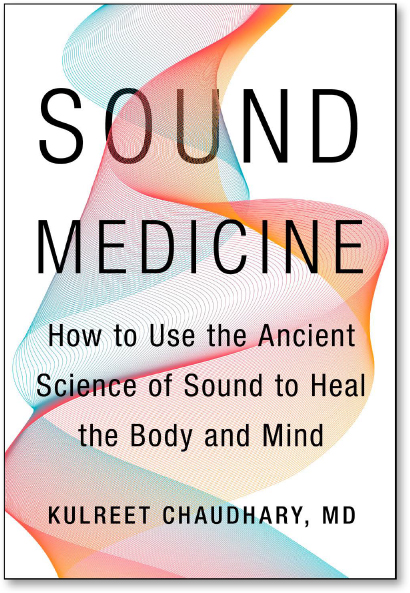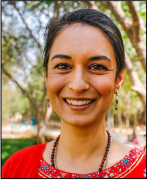Sound Medicine§
Healing with Vibration§
“Music gives a soul to the universe, wings to the mind,
flight to the imagination and life to everything.” —PLATO§
Dr. Kulreet Chaudhary, the author of this Insight, published a new book this year entitled Sound Medicine, sharing her years of experience with this subtle healing art. Here is an excerpt.§
 OOKING BACK ON MY LIFE HISTORY, IT MAKES SENSE THAT IT HAS ALways felt effortless for me to move between the world of sound medicine—with elements drawn variously from ancient cultures and quantum physics—and the world of neurology, with its more intellectual, independent approach to the body. My early exposure to both Vedic medicine and quantum physics helped me to understand the dissonance between my inner reality—the timeless, disembodied realm of my meditations—and the external reality, in which I collectively took part at medical school and in the professional world.§
OOKING BACK ON MY LIFE HISTORY, IT MAKES SENSE THAT IT HAS ALways felt effortless for me to move between the world of sound medicine—with elements drawn variously from ancient cultures and quantum physics—and the world of neurology, with its more intellectual, independent approach to the body. My early exposure to both Vedic medicine and quantum physics helped me to understand the dissonance between my inner reality—the timeless, disembodied realm of my meditations—and the external reality, in which I collectively took part at medical school and in the professional world.§
Yet even with this particular ability to straddle both worlds, I still find it a challenge to wrap my mind around some of the more black-and-white models of science. In medical school, for example, I had difficulty with chemistry as well as classical physics—not because I couldn’t understand the principles, but rather because I struggled to accept them as being ultimately true. Some of the concepts stood in stark contrast to the way I intuitively understood the world. When we learned about how neurotransmitters work with receptors, for example, I was steeply challenged by the notion that all it takes for a neurotransmitter to bind to a receptor—triggering the electrical signals that inform our complex thoughts and rich emotions—is for it to randomly slam into it. (When this happens, the neurotransmitter “unlocks” the cell’s response—giving rise to the term “lock-and-key”—causing changes to it.) There is something so inelegant about this idea, as if our thoughts arrive on a system akin to bumper cars. It felt at odds with the sophisticated design of our brains; it just didn’t seem a complete or thorough enough explanation to me.§
I also couldn’t accept that the intense energetic connectedness I’d encountered in my mantra meditations—the same energy that had helped my patients to improve their health—should be omitted from medical explanations to patients. I knew that deepening our connections with our silent inner realities and letting go, if only temporarily, of the ping-ponging thoughts and unchecked emotions we experience all day long has a measurable and dramatic effect, making me and my patients not only physically and mentally healthier but also happier and more capable in our everyday lives.§
Vibratory vitality: Cover of the author’s newest book;§
The current Western model doesn’t have a definitive, or complete, explanation for what creates consciousness. We know that too much or too little of a particular neurotransmitter can have a negative psychological outcome; we understand that information from the brain is relayed to the body via the spinal cord and the peripheral nerves in the peripheral nervous system. But how our complex thoughts and emotions actually form is not accounted for in these mechanisms. I have come to believe that there is something missing from our understanding, something that would account for how our bodies receive and transmit information.§
The answer to that question, and the way I have come to bridge the gap between physiology and consciousness, is a sense of spirituality. Before you mistake my use of this word to mean that I am trying to imbue medicine with religion, let me explain. In the Vedic tradition, the spirit is considered to be that which animates the body and gives us consciousness, as well as the ability to be aware of oneself in the world. It is the distinguishing mark of living things and our vitalizing force. Early Greek philosophers would have called this the soul, but you could also call it qi, as Chinese philosophy refers to this energy flow, or Brahman in the manner of the Vedic scholars. I do not believe there is only one right term; I mean all of these things when I refer to spirituality. If we don’t take into account that which makes us living beings—that is, if we discount energy as a meaningful entity in medicine—we cannot comprehensively address our health.§
In Western thought, quantum physics is uniquely reflective of energy’s underlying and essential role in the universe; indeed this discipline describes nature at the smallest scales of energy levels. Throughout my studies, it has been a place of profound resonance for me, since it proposes scientific explanations, as well as a modern context, for the metaphysical revelations of Vedic medicine. I believe that holding in mind both the sense of spirit proposed by the ancients and the rigor and research of science will allow us to open our minds to valuable and beneficial therapies, particularly in the realm of sound medicine.§
From the Book§
 HY DOES A BABY’S CRY INSTANTLY FLOOD A MOTHer’s body with a myriad of stress hormones? How can a song on the radio stir up powerful emotions, from joy to anger, regret to desire? Why does sound itself evoke such primal and deeply felt emotions?§
HY DOES A BABY’S CRY INSTANTLY FLOOD A MOTHer’s body with a myriad of stress hormones? How can a song on the radio stir up powerful emotions, from joy to anger, regret to desire? Why does sound itself evoke such primal and deeply felt emotions?§
Sound is a vibration that travels through air, water and solids. It’s produced by all matter and is a fundamental part of survival for every species. Yet there is a hidden power within sound that has only begun to be investigated. From leading neurologist, ayurvedic expert and author Dr. Kulreet Chaudhary comes SOUND MEDICINE: How to Use the Ancient Science of Sound to Heal the Body and Mind, a rigorous scientific investigation of the healing power of sound. This practical guide demonstrates how readers can use sound to improve their mental and physical well-being, taking them on a journey through the structure of the mouth, ears and brain to understand how sound is translated from acoustic vibrations into meaningful neurological impulses. Dr. Chaudhary explains how different types of sound impact the human body and brain uniquely, and explores the physiological effects of sound vibration, from altering mood to healing disease.§
Blending ancient wisdom with modern science, SOUND MEDICINE traces the history of sound therapy and the use of specific mantras from previously unknown texts—traced back to the Siddhas, a group of enlightened masters who created a healing tradition that served as the precursor to ayurvedic medicine—to explain the therapeutic application of sounds for a wide range of conditions. Dr. Chaudhary offers practical, step-by-step lessons for using music and mantras, whether you’re a beginner or searching for a more advanced practice, to improve your health in body, mind and spirit.§
Hardcover: 272 pages, 6 x 9 inches; Harper Wave, 2020. Link to Purchase the Book: bit.ly/SoundMedicineAmazon§
Inner courtyard of the clinic in Vellore, India, overseen by the author§
ABOUT THE AUTHOR§
Dr. Kulreet Chaudhary is an integrative neurologist, neuroscientist and the former director of Wellspring Health at Scripps Memorial Hospital. She received her Internship in Internal Medicine at UCLA and her Neurology Fellowship from UCSD. She has participated in over twenty clinical research studies in the areas of multiple sclerosis, Alzheimer’s disease, Parkinson’s disease, ALS and diabetic peripheral neuropathy. She is currently the head of the Sri Narayani Holistic Centre in Tamil Nadu, India, where she is implementing the use of sound medicine into the treatment of chronic disease, and also studying the ancient Siddha texts that have been hidden from public view for centuries. Dr. Chaudhary is the author of The Prime and a new book, Sound Medicine. She has appeared as a medical expert on numerous programs, including The Dr. Oz Show and Home & Family.§
For more information visit: drkulreetchaudhary.com. For more about the Sri Narayani Holistic Centre, visit snhcentre.com.§



